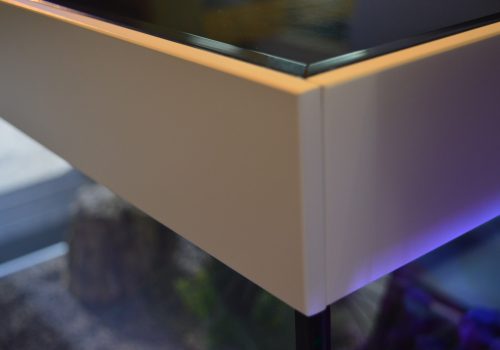

That said though, the overflow offers a bit more flexibility and protection. You might be asking yourself why don’t I skip the overflow and just put a drain pipe in. This way the height of the water in the tank will not exceed the height of the overflow and when the power goes off the tank will only drain until it reaches the top of the overflow (though be careful about back siphons down your return pump line). The excess water flows over and then proceeds down the drain and into the sump. The only way water goes over and into the overflow is if the water level in the main tank exceeds the height of the overflow. You have the high water side of the dam (inside the tank) and the low water side (inside the overflow where the drain is).

The top of the dam is the overflow teeth. When you setup an overflow in a tank you are essentially creating a dam. Really this concept is just gravity at work. One of the biggest benefits (and most misunderstood concepts) of an overflow is how they maintain steady water levels in the display tank and are self-regulating. The principles with an external overflow are the same, just the means of getting water over the side of the tank is different and I will get into more detail with towards the end. For the purpose of explaining overflows I am going to use the internal overflow as the example. First is the internal overflow and second is the external overflow. Your typical self-installed overflow will fall into one of two categories. If you’re more interested in how the concept works, then keep reading!
AQUARIUM OVERLOOP INSTALL
In the case of an internal overflow, it’s worth mentioning that you want to make sure you have enough room for any fittings you plan to install as well, but generally speaking they are all sized to house typical size plumbing fittings anyway. If you have a return pump that’s going to be 500gph, get an overflow rated for at least 500gph, as long as the overflow is big enough it will self-regulate itself to any pump slower. If you’re looking for the simple answer to “What size overflow do I need?” The answer is: Purchase an overflow that is rated for more flow (generally rated in Gallons per Hour) then your return pump will be. I think the hesitation and the question comes in from the fact that how an overflow system works seems complicated though, like most things, once explained it turns out to be pretty simple. One of the most common questions I see is “How big of an overflow do I need to buy” and it’s a bit ironic because the answer is so much simpler than most folks expect it to be. They allow you to hide all your ugly equipment outside of your display tank, allow you to use bigger, better, and more equipment, and they make for a steady water level in your display tank.
AQUARIUM OVERLOOP SERIES
Whether it be common municipal water issues of hardness, lead, and chlorine or the myriad of contaminants associated with problem well water, Evolve Series equipment has a comprehensive affordable solution.Overflows are great. These systems utilize advanced technology to provide homes and businesses with the most efficient soft pure water today. The Evolve Series is Water Right's platinum line of water softening and filtration systems. In 2011 NMP Partnered with the Water Right Group, an American Manufacturer of high quality water conditioning and purification equipment, based in Appleton, Wisconsin. NMP Proud to Be a Water Right/Evolve Dealer It has more than 2,500 members consisting of both manufacturers as well as dealers/distributors of equipment. The WQA is an Illinois-based trade association representing the residential, commercial, industrial, and small community water treatment industry in the United States. Tim Van Overloop, President of NMP Water Systems LLC, has made the commitment to be certified by the Water Quality Association (WQA) as an installer and a certified water specialist.


 0 kommentar(er)
0 kommentar(er)
